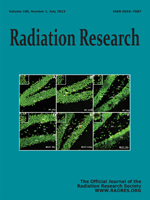We have investigated how radiation quality affects the induction of chromosomal aberrations in human cells. Human lymphocytes were irradiated in vitro with various energies of accelerated high charge and energy (HZE) particles including oxygen, neon, silicon, titanium and iron. Chromosome damage was assessed using three-color FISH chromosome painting in chemically induced premature chromosome condensation samples collected at first cell division after irradiation. The LET values for these particles ranged from 30 to 195 keV/μm, and their energies ranged from about 55 MeV/u to more than 1,000 MeV/u. The 89 and 142 MeV/u neon particles produced the most simple-type reciprocal exchanges per unit dose. For complex-type exchanges, 64 MeV/u neon and 450 MeV/u iron were equally effective and induced the greatest amount of complex damage. Track structure models predict that at a fixed value of LET, particles with lower charge number (Z) will have a higher biological effectiveness compared to particles with a higher Z, and that a saturation cross section will be observed for different radiation qualities. Our results are consistent with model expectations within the limitation of experimental error, and provide the most extensive data that have been reported on the radiation quality dependences of chromosomal aberrations.
How to translate text using browser tools
31 May 2013
Biological Effectiveness of Accelerated Particles for the Induction of Chromosome Damage: Track Structure Effects
Kerry A. George,
Megumi Hada,
Lori Chappell,
Francis A. Cucinotta
ACCESS THE FULL ARTICLE

Radiation Research
Vol. 180 • No. 1
July 2013
Vol. 180 • No. 1
July 2013




